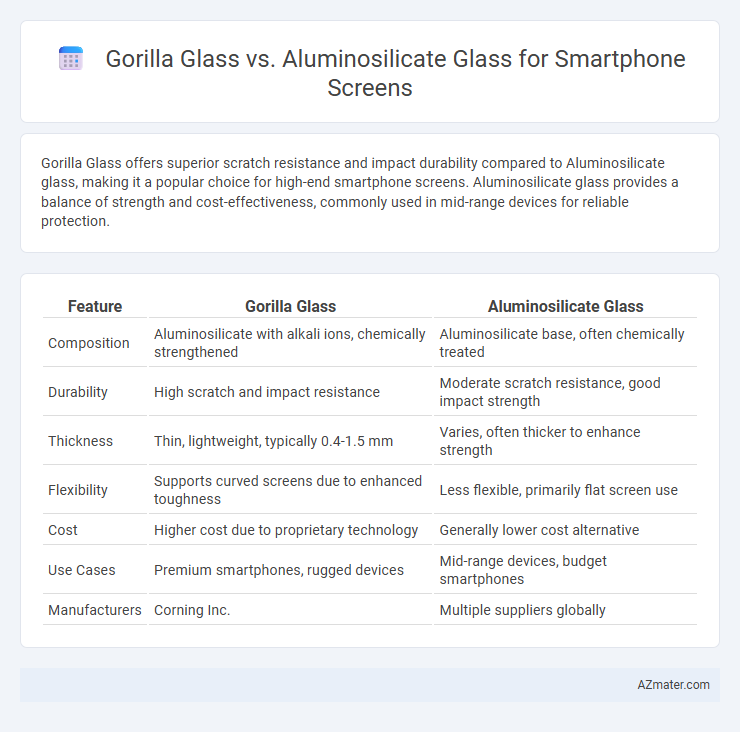Gorilla Glass offers superior scratch resistance and impact durability compared to Aluminosilicate glass, making it a popular choice for high-end smartphone screens. Aluminosilicate glass provides a balance of strength and cost-effectiveness, commonly used in mid-range devices for reliable protection.
Table of Comparison
| Feature | Gorilla Glass | Aluminosilicate Glass |
|---|---|---|
| Composition | Aluminosilicate with alkali ions, chemically strengthened | Aluminosilicate base, often chemically treated |
| Durability | High scratch and impact resistance | Moderate scratch resistance, good impact strength |
| Thickness | Thin, lightweight, typically 0.4-1.5 mm | Varies, often thicker to enhance strength |
| Flexibility | Supports curved screens due to enhanced toughness | Less flexible, primarily flat screen use |
| Cost | Higher cost due to proprietary technology | Generally lower cost alternative |
| Use Cases | Premium smartphones, rugged devices | Mid-range devices, budget smartphones |
| Manufacturers | Corning Inc. | Multiple suppliers globally |
Introduction: Gorilla Glass vs Aluminosilicate Glass
Gorilla Glass and Aluminosilicate glass are two prominent materials used in smartphone screens, both valued for their durability and resistance to scratches. Gorilla Glass is a chemically strengthened aluminosilicate glass developed by Corning, known for its enhanced toughness and impact resistance compared to standard aluminosilicate glass. In contrast, Aluminosilicate glass refers to a broader category of glass made primarily from aluminum oxide and silicon dioxide, offering solid mechanical strength but generally less advanced chemical strengthening than Gorilla Glass.
What is Gorilla Glass?
Gorilla Glass is a chemically strengthened aluminosilicate glass specifically engineered by Corning to provide superior scratch resistance and durability for smartphone screens. This ultrathin, damage-resistant glass undergoes an ion-exchange process that enhances its surface compression, making it tougher against drops and impacts compared to standard aluminosilicate glass. Its advanced material composition and reinforced structure significantly improve touchscreen longevity and visual clarity in mobile devices.
What is Aluminosilicate Glass?
Aluminosilicate glass is a durable material commonly used in smartphone screens due to its high resistance to scratches and impact. Composed of aluminum oxide and silicon dioxide, it offers enhanced strength and thermal stability compared to regular glass. This makes aluminosilicate glass a popular alternative to Gorilla Glass for providing reliable protection while maintaining touchscreen sensitivity.
Durability Comparison: Scratch and Impact Resistance
Gorilla Glass, engineered by Corning, offers superior scratch resistance due to its chemically strengthened aluminosilicate composition, enhancing surface hardness and reducing abrasion. Aluminosilicate glass also provides robust impact resistance but generally falls short of Gorilla Glass in withstanding repeated drops and impacts without cracking. The proprietary ion-exchange process in Gorilla Glass creates a compressive layer that improves durability, making it the preferred choice for premium smartphone screens demanding high scratch and impact resistance.
Transparency and Display Clarity
Gorilla Glass offers superior transparency and enhanced display clarity due to its chemically strengthened aluminosilicate composition, which reduces surface imperfections and light distortion. Aluminosilicate glass, while providing good durability, may exhibit slightly lower transparency and higher light scattering, potentially impacting screen sharpness and color accuracy. The advanced ion-exchange process used in Gorilla Glass optimizes optical performance, making it the preferred choice for high-resolution smartphone displays.
Weight and Thickness Considerations
Gorilla Glass offers a thinner and lighter profile compared to aluminosilicate glass, enhancing smartphone portability and sleekness. Its chemically strengthened composition allows for reduced thickness without compromising durability, directly impacting device weight. Aluminosilicate glass, while durable, tends to be thicker and heavier, which can add bulk to smartphone screens and overall device structure.
Cost and Manufacturing Differences
Gorilla Glass, made from aluminosilicate but chemically strengthened through ion exchange, generally incurs higher manufacturing costs due to specialized processes ensuring superior durability and scratch resistance. Aluminosilicate glass, while also robust and used in many smartphone screens, is produced at lower costs with simpler treatments, making it more economical for budget devices. Cost differences stem from Gorilla Glass's proprietary strengthening techniques and quality control standards, often translating to higher retail prices in premium smartphones.
Smartphone Brands: Glass Preferences
Smartphone brands often prefer Gorilla Glass for its superior scratch resistance and durability, making it the standard choice for high-end models from Apple, Samsung, and OnePlus. Aluminosilicate glass, while less resistant to impact, is favored by brands aiming for cost-effective solutions and moderate durability, common in budget and mid-range devices from brands like Xiaomi and Realme. The choice between Gorilla Glass and Aluminosilicate glass significantly impacts the device's overall screen resilience and user experience.
User Experience and Long-Term Performance
Gorilla Glass offers superior scratch resistance and toughness due to its chemically strengthened aluminosilicate composition, enhancing long-term durability and maintaining screen clarity. Aluminosilicate glass, while also providing good hardness, tends to be more prone to micro-fractures under heavy impact, potentially reducing touch responsiveness and visual sharpness over time. Users benefit from Gorilla Glass's better resistance to everyday wear and accidental drops, which translates into a more reliable and consistent smartphone experience throughout the device's lifespan.
Which Glass is Best for Your Smartphone?
Gorilla Glass offers superior scratch resistance and enhanced durability due to its chemical strengthening process, making it ideal for high-impact smartphone use. Aluminosilicate glass, while slightly less scratch-resistant, provides excellent thermal resistance and cost-effectiveness, often found in mid-range smartphone models. Choosing the best glass depends on your priority for either maximum toughness and scratch protection with Gorilla Glass or balanced performance and affordability with Aluminosilicate glass.

Infographic: Gorilla glass vs Aluminosilicate glass for Smartphone screen
 azmater.com
azmater.com